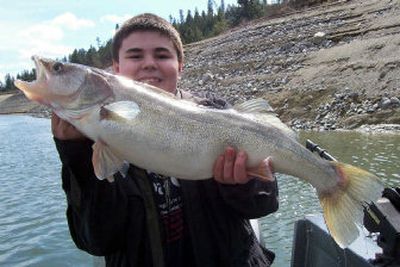Wary of walleyes

Walleyes aren’t native to Northwest streams and lakes, but they were here before the influx of Californians, and they’re probably more highly regarded.
Salmonid-oriented Washington fisheries managers gave up trying to curb the spread of the toothy predators decades ago. Now the task is to keep walleyes as well as smallmouth bass from falling victim to their own success in lakes such as Moses, Potholes, Sprague and Roosevelt.
“We need to harvest more fish out of these lakes,” said Steve Jackson, Washington Department of Fish and Wildlife warmwater fisheries manager. “Some of these waters have incredible densities of walleye. They’re having an enormous impact on perch, crappie and bluegills, essentially eating themselves out of house and home.”
Starting Monday, new Washington fishing regulations will allow anglers to take home more smaller-size walleyes as well as smallmouth bass, another species that’s overpopulating fishing lakes.
“The new regulation allows anglers to keep just about any walleye they catch (in the designated waters), but it limits them to one trophy-size fish,” Jackson said.
Technically, the big walleyes need no special protection in order to maintain walleye populations, he said. But department officials understand that maintaining a trophy fishery generates excitement among anglers ranging from neophytes to tournament pros.
Trophy walleye aren’t produced overnight. A 10-pounder in Lake Roosevelt is 8 to 12 years old, he said.
“There’s no biological reason to release the big ones because they are a very reproductive species,” he said. “They can overpopulate. On the other hand, everybody likes knowing there’s a chance of catching a big one.”
But to keep the fisheries in balance, anglers are going to have to bonk more of the smaller walleyes and smallmouths, he said.
“People don’t want to keep smallmouths to eat even though they’re probably just as good as perch and other white-fleshed fish,” he said.
“About 70 percent of the walleyes caught are kept for eating because it’s well-accepted that walleyes are among the best eating fish around. Actually, it’s amazing that we have 30 percent catch-and-release.
“But only 5 percent of smallmouth are kept.
“In some of our lakes, where they produce fairly well and have a good forage base, releasing this many walleye and smallmouths exacerbates the problem.”
The new regulations increase the daily limit and extend the maximum size for walleye on Lake Roosevelt while removing the minimum size and doubling the daily limit for smallmouth.
“We haven’t had a minimum size on Roosevelt walleyes because of all the small fish,” Jackson said. “We dropped the minimum on Moses, Potholes and Sprague to get more harvest.
“Anglers are taking only about 3 percent of the harvestable population of walleyes on Moses Lake, probably higher on Potholes but lower on Sprague.
“You can take up to 30 percent of the harvestable population and maintain a viable fishery, but we’re nowhere near that. These fish, for most part, are dying of natural causes.”
Washington’s biggest walleyes — indeed, perhaps the largest collection of trophy walleyes in the nation — are in the lower Columbia River. “We manage them differently down there because their forage base is different and the walleyes are in much lower densities,” Jackson said.
“The whole issue in warmwater fisheries is balance between predator and forage.
“On the lower Columbia, the forage isn’t crappie and perch, it’s sculpins and crayfish. There’s a rich supply of food, but densities are lower and they’re not hammering their forage base.
“(Lake Roosevelt) is very productive with fairly dense populations in a moderately sterile environment and a forage base that’s becoming less dense.”
At Banks Lake and Scootenay Reservoir, the walleye are in better balance with their forage, he said, noting the more restrictive statewide rules will continue to apply there.
“We have a big job ahead of us to educate anglers on why we have these different regulations on different waters,” he said.